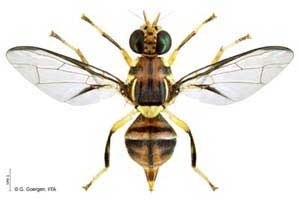Carambola fruit fly
(Bactrocera carambolae)

Description
Bactrocera carambolae, also known as the carambola fruit fly, is a fruit fly species in the family Tephritidae, and is native to Asia. This species was discovered by Drew and Hancock in 1994. Bactrocera carambolae are specifically native to Malaysia, southern Thailand and western Indonesia. In past years, this species has invaded South America via the trade of fruits from Indonesia. This species is known as a major exotic pest, labelled as high priority in the Tropical Fruit Industry Biosecurity Plan and a quarantine pest in Brazil. Bactrocera carambolae is a member of the Oriental fruit fly Bactrocera dorsalis species complex and are genetically similar except for slight differences in nuclear and mitochondrial DNA. From DNA analyses it was determined that B. carambolae forms a reciprocally monophyletic sister group to a larger clade containing the B. dorsalis species complex. Bactrocera carambolae can be difficult to distinguish from other B. dorsalis complex species. This species is generally characterized by a predominantly black thorax, while featuring abdominal segments with brown lateral posterior markings and a medial longitudinal black band over all three tergum. This species also features a yellow scutellum; triangle shaped portion of exoskeleton located between the base of the wings. In addition to other Diptera, this species has one pair of membranous wings, with hind wings reduced to knob-like structures. The head of this species is reddish brown with one pair of oval, black compound eyes, and sucking/piercing mouthparts. This species can reach a length of 6 to 8 mm (0.6 cm to 0.8 cm). Female B. carambolae can be differentiated from male B. carambolae by observation of longer abdomens, and an ovipositor on the posterior end of the abdominal segments, where as males have shorter abdomens and a more rounded tip of their abdominal segments. Compared to other members of the B. dorsalis complex, B. carambolae have shorter male reproductive organs, known as aedeagi, and broader costal bands on their wings. Bactrocera carambolae are a polyphagous species which infects over 100 different host plants, including avocado, guava, mango, papaya and orange, among several others. The adult female B. carambolae lays her eggs under the skin of host fruits, which take a maximum of two days to hatch. Once the larvae hatch, they immediately begin feeding on the fruit.
Taxonomic tree:







